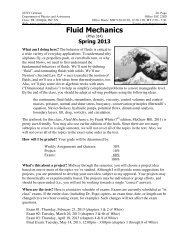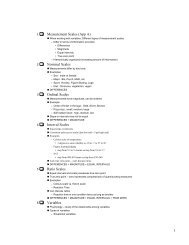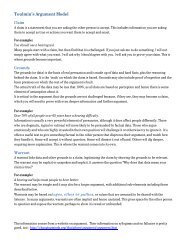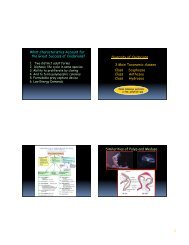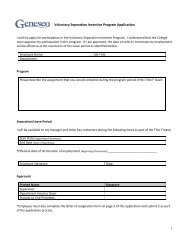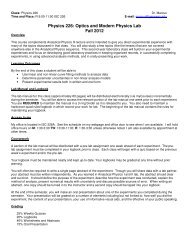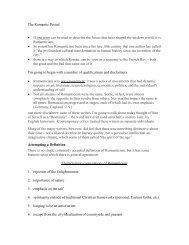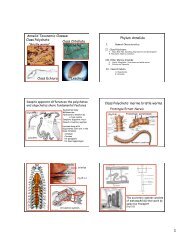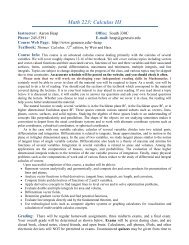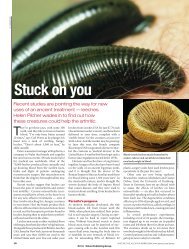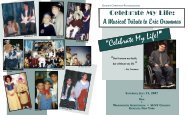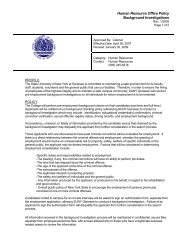Moist Wound Healing
Moist Wound Healing
Moist Wound Healing
You also want an ePaper? Increase the reach of your titles
YUMPU automatically turns print PDFs into web optimized ePapers that Google loves.
<strong>Moist</strong> <strong>Wound</strong> <strong>Healing</strong> with<br />
Advanced <strong>Wound</strong> Care<br />
Products<br />
Kathy Brown RN MN CWOCN<br />
Nurse Manager WOC Program<br />
University of Rochester Medical Center<br />
Strong Memorial Hospital<br />
1
Topical Therapy<br />
Creating the optimal microenvironment for healing:<br />
• Remove necrotic tissue and foreign particles<br />
• Identify and eliminate infection<br />
• Obliterate dead space<br />
• Absorb excess exudate<br />
• Maintain a moist wound surface<br />
• Provide thermal insulation<br />
• Protect the healing wound from trauma and<br />
contaminants<br />
2
Advantages of <strong>Moist</strong> <strong>Wound</strong><br />
<strong>Healing</strong><br />
• <strong>Healing</strong> time is reduced<br />
• Patient experiences less pain<br />
• Fewer infections of the wound<br />
• Reduces total cost of wound care<br />
3
Principles of <strong>Moist</strong> <strong>Wound</strong><br />
<strong>Healing</strong><br />
• The moisture vapor transmission rate (MVTR) per<br />
square meter of skin per day is:<br />
– 200 grams of moisture through intact skin<br />
– 7874 grams of moisture through compromised stratum<br />
corneum<br />
• A wound that becomes dry will incur further tissue<br />
death (dehydration necrosis)<br />
– Cells needed for healing migrate faster and further in a<br />
moist environment<br />
4
<strong>Moist</strong> <strong>Wound</strong> <strong>Healing</strong><br />
•This means no wound should<br />
ever scab or crust! That isn’t<br />
moist wound healing…<br />
5
Students as Patients<br />
• Your patient population is truly unique<br />
• They think they’re invincible<br />
• Usually young, otherwise healthy<br />
• Problems with keeping the dressings<br />
on!<br />
• Suggest a MVI with minerals QD<br />
6
<strong>Wound</strong> Cleansing Guidelines<br />
• Clean wound – one that is free of necrotic<br />
tissue and is granulating and/or<br />
epithelializing<br />
• The goal is to minimize the disruption of<br />
the wound’s surface<br />
• Normal saline is the solution of choice …<br />
– No Whirlpool!<br />
7
Blairex <strong>Wound</strong> Wash Saline<br />
8
Blairex <strong>Wound</strong> Wash Saline<br />
• Sterile normal saline solution<br />
• Painlessly flushes & cleans wounds of all<br />
debris and infection<br />
• Can works upside down even!<br />
• Low psi = will not harm healthy tissue<br />
• Non-stinging, preservative free, remains<br />
sterile<br />
9
<strong>Wound</strong> Cleansing Guidelines<br />
Necrotic <strong>Wound</strong>s<br />
• For necrotic wounds the goal is an<br />
antimicrobial effect without being<br />
cytotoxic to cells required for wound<br />
healing<br />
10
<strong>Wound</strong> Cleansing Guidelines<br />
Necrotic <strong>Wound</strong>s<br />
• Betadine (Povodone-Iodine)<br />
– Positive aspects<br />
• Broad spectrum antibiotic<br />
• Readily available<br />
– Negative side effects<br />
• Toxic to fibroblasts<br />
• Never approved for internal use by the FDA<br />
• Could be systemically absorbed<br />
• Harsh to intact, uninjured skin<br />
• Antimicrobial effect only lasts 10 minutes<br />
11
<strong>Wound</strong> Cleansing Guidelines<br />
Necrotic <strong>Wound</strong>s<br />
• Dakin’s solution (sodium hypochlorite)<br />
– Positive aspects<br />
• Has an antimicrobial effect on staph, strep, MRSA<br />
• Is effective in debriding<br />
– Negative side effects<br />
• Toxic to fibroblasts<br />
• Ulcerates granulation tissue<br />
• Burns intact uninjured skin<br />
• Antimicrobial effect only lasts 10 minutes<br />
12
<strong>Wound</strong> Cleansing Guidelines<br />
Necrotic <strong>Wound</strong>s<br />
• Acetic Acid (vinegar)<br />
– Positive aspects<br />
• Readily available<br />
– Negative side effects<br />
• Is only toxic to pseudomonas in concentrations that<br />
are also toxic to cells needed for wound healing!<br />
• - There is no place for acetic acid in<br />
evidence-based wound care<br />
13
<strong>Wound</strong> Cleansing Guidelines<br />
Necrotic <strong>Wound</strong>s<br />
• Hydrogen peroxide (for blonde wounds)<br />
– Positive aspects<br />
• Good mechanical cleanser and debrider<br />
• Readily available<br />
– Negative side effects<br />
• Can cause an air embolism if used to pack or irrigate<br />
• Ulcerates granulation tissue<br />
• Antimicrobial effect short lived!<br />
14
Factors Influencing Dressing<br />
– Anatomical site<br />
Choice<br />
– Amount of exudate<br />
– Dead space<br />
– Surrounding skin<br />
– Caregiver ability<br />
– <strong>Wound</strong> status<br />
16
Factors Influencing Dressing<br />
Choice<br />
– Aggressive therapy vs. palliative care<br />
– Cost<br />
– Availability<br />
– Reimbursement<br />
17
Advanced <strong>Wound</strong> Care<br />
Products<br />
• Remove impediments to healing<br />
• Do not “speed up “ healing<br />
• Biologically active advanced wound care<br />
products are available: growth factors, skin<br />
substitutes, wound matrixes, manufactured<br />
human skin<br />
18
Types of Dressings<br />
• Gauze -<br />
19
What’s So Bad About<br />
Gauze?<br />
• Poor bacterial barrier<br />
• Minimal absorption<br />
• Painful removal<br />
• Overpacks<br />
• No barrier to<br />
urine/stool<br />
• Not a moist wound<br />
bed<br />
• Costly!<br />
• Leaves fibers behind<br />
• Indiscriminate<br />
debrider if wet-to-dry<br />
• Delayed wound<br />
closure<br />
• Not skilled nursing?<br />
20
Advanced <strong>Wound</strong> Care<br />
- Hydrocolloids<br />
Products<br />
– Hydrogels<br />
– Alginates<br />
– Foams<br />
– Transparent films<br />
– Hydrofibers<br />
– Silver dressings<br />
21
Dressings<br />
22
Skin Sealant Wipes<br />
• Purpose: minimize skin stripping due to<br />
adhesives<br />
• Puts a layer of plastic film on the skin<br />
• Most contain alcohol – newer ones don’t<br />
• Must dry before application of adhesive<br />
• Is NOT a skin cleaner or an adhesive<br />
• Examples: Skin Prep, Cavilon No-Sting<br />
wipes
Skin Sealant Wipes<br />
• Are especially important for your<br />
population!<br />
• Dressings may need to be taped on !<br />
• Skin sealants protect the skin from tape and<br />
from the potentially macerating effects of<br />
wound drainage on skin<br />
24
#3M Cavilon No-Sting Wipes<br />
25
Transparent Film Dressings<br />
26
Thin Films<br />
• Transparent Films – Tegaderm, Op-Site<br />
27
Transparent Film Indications<br />
– Shallow wounds to act as a covering to maintain<br />
moist wound bed<br />
– Waterproof site from moisture<br />
– May protect from friction and shear<br />
– Promotes autolytic debridement<br />
– May reduce pain by keeping nerve endings in a moist<br />
state<br />
– No absorption – can be tricky to apply<br />
28
<strong>Wound</strong>s For Transparent Film<br />
29
Smith & Nephew<br />
OPSITE Post-op Dressing
Op-Site Post-Op Dressing<br />
3 sizes available<br />
• Overall sizes:<br />
– 2 ½ x 2 in.<br />
– 6 1/8 x 3 3/8 in.<br />
– 10 x 3 in.<br />
*pad size in center is smaller
Benefits of<br />
Op-Site Post-op Dressing<br />
• Barrier to bacteria and contaminents<br />
• Waterproof, conformable and comfortable<br />
• Easy to apply and remove aseptically<br />
• Allows for monitoring of the peri-wound area
Op-Site Post-op Dressing<br />
How To Apply<br />
• Clean skin with<br />
normal saline first<br />
• Make sure you<br />
protect the skin with<br />
skin sealant<br />
• Step 1: Remove paper #1 first<br />
• Step 2: Apply the dressing<br />
• Step 3: Remove the stabilizing<br />
layer (labeled #2)<br />
• Change whenever<br />
soiled
Hydrocolloid Dressings<br />
35
Hydrocolloid Dressings<br />
– Wafers made from gelatin, pectin, colloids, and<br />
carboxymethyl-cellulose<br />
– Considered occlusive dressings<br />
– Can be left in place for up to 7 days<br />
– Can be a secondary dressing over a hydrofiber<br />
– One of the oldest advanced wound care products<br />
36
Hydrocolloids<br />
37
Hydrocolloid Indications<br />
– Indicated for shallow<br />
wounds with minimal to moderate<br />
exudate<br />
– Facilitates in creating a moist<br />
wound environment to increase<br />
fibrinolysis<br />
– <strong>Moist</strong>ure may also reduce<br />
pain to nerves<br />
- Facilitates autolytic debridement<br />
- Good for scrapes and abrasions<br />
38
Advantages of Hydrocolloids<br />
– Waterproof<br />
– Good bacterial barrier<br />
– Absorptive<br />
– Flexible<br />
– Long wear time<br />
– Ease of use<br />
39
Disadvantages<br />
– Risk of hypergranulation tissue<br />
– Melting down<br />
– Occlusion and odor<br />
– Must be removed appropriately = slowly<br />
– Not for wounds with undermining or tunneling (anaerobes)<br />
– Can be dislodged in the presence of heavy exudate so<br />
– Not for heavily draining wounds<br />
40
Hydrogels<br />
42
– Water or glycerin based<br />
Hydrogels<br />
– Available in amorphous gels, sheets, or<br />
impregnated in gauze<br />
– Limited absorptive capacity<br />
– Considered hydrators<br />
– Viscosity varies by manufacturer<br />
– Available in sterile one-time usage or in<br />
multi-application forms<br />
43
Hydrogels<br />
44
Hydrogel Indications<br />
– Assist wound in maintaining a moist<br />
wound environment<br />
– Insulator<br />
– <strong>Moist</strong> wound environment may promote<br />
autolytic debridement<br />
– No absorptive capability<br />
45
Hydrogel with Thin Film<br />
Autolytically Debriding Eschar<br />
46
<strong>Wound</strong>s for Hydrogel Dressing<br />
47
Advantages Hydrogels<br />
– Rehydrate the wound bed<br />
– Soothing<br />
– Longer wear time than damp gauze<br />
– Easy to apply and remove<br />
– In gauze form can be used to fill wounds<br />
– Does not leave residue in wounds<br />
– Facilitates autolytic debridement<br />
48
Disadvantages Hydrogels<br />
– Depends on viscosity for wear time<br />
– Can put a non-adherent dressing over it to keep it moist<br />
– Not absorptive = for dry wounds<br />
– Requires a secondary dressing<br />
49
Alginate Dressings<br />
50
Alginate Dressings<br />
– Derived from seaweed<br />
– Soft, non-woven fibers of a cellulose-like<br />
polysaccharide<br />
– Available in ropes for filling and flat pads for open<br />
wounds -<br />
– Weaving techniques vary among manufacturers<br />
51
Alginate Indications<br />
– <strong>Wound</strong>s with moderate to heavy drainage<br />
– <strong>Wound</strong> filling<br />
– May use in infected wounds<br />
– Interacts with wound fluid to form a gel creating a<br />
moist wound environment<br />
– Leg ulcers, non-healing surgical wounds,<br />
full thickness wounds<br />
52
<strong>Wound</strong>s for Alginate Dressing<br />
53
Advantages Alginates<br />
– High capacity for absorption<br />
– Easy to apply<br />
– May be used under compression<br />
- An atraumatic removal = no pain!<br />
54
Disadvantages of Alginates<br />
• - must be used cautiously on patients<br />
allergic to seafood<br />
• -looks and smells NASTY when removing<br />
old dressing<br />
55
Aquacel - A Hydrofiber<br />
-Man-made hydrofiber<br />
-More absorptive than an alginate<br />
-Turns into a gel that protects healthy tissue<br />
- & autolytically debrides unhealthy tissue<br />
-OK to use on patients allergic to seafood<br />
-Needs a secondary dressing like foam or<br />
hydrocolloid<br />
56
Hydrofibers<br />
• Aquacel<br />
57
Gelled Calcium Alginate<br />
58
Aquacel AG …………….<br />
• A man-made hydrofiber that is very absorptive<br />
• With silver added for a sustained antimicrobial<br />
effect, non toxic to healing cells<br />
• Hydrofiber will autolytically debride if needed<br />
• Atraumatic to granulating tissue = a painless<br />
removal<br />
• Can use saline to clean wound<br />
59
Important to Remember…<br />
•You CAN NOT judge how the<br />
wound is healing by the look or<br />
smell of the old dressing!!<br />
63
Silvasorb Gel<br />
• Instead of Neosporin / Polysporin<br />
• For dry or lightly draining wounds- all types<br />
• Continuous antimicrobial protection<br />
• Helps manage bacterial burden of wound<br />
• Non-staining = won’t tarnish wound bed<br />
• Needs a cover dressing,<br />
• 3 day wear time<br />
64
Medihoney Dressings<br />
67
Medihoney Dressings<br />
• Made from honey derived from the pollen<br />
& nectar of specific Leptospermum species<br />
of plants from New Zealand<br />
• Cleans and debrides wounds due to its high<br />
osmolarity, lowers wound bed pH, which ↑<br />
oxygen diffusion & ↓protease activity<br />
68
Medihoney Dressings<br />
• Non-toxic, natural & safe<br />
• The only species of honey that’s been<br />
shown in RCT to help wounds that have<br />
stalled…jumpstarts the healing process<br />
• Manuka honey<br />
69
Medihoney Dressings<br />
• - Medihoney paste – thicker, 100% honey<br />
• - Medihoney gel – newer, 80% honey<br />
• - Medihoney calcium alginate – absorbs<br />
• - Medihoney Honeycolloid - with and<br />
without adhesive<br />
70
Foams<br />
72
Foam Dressings<br />
– Composed of polyurethane foam<br />
– Hydrophilic properties<br />
– Vary in thickness<br />
– May have film backing on outer surface<br />
– Available in adhesive or non-adhesive sheets, pillows<br />
or wafers<br />
73
Foam Indications<br />
– Able to absorb light to heavy amounts of exudate<br />
– Semi-occlusive<br />
– Fills in in dead space<br />
– Maintain moist wound environment<br />
– May retard hypergranulation tissue<br />
74
Foam Sizes<br />
75
Advantages Foam Dressings<br />
• Also good for:<br />
• - cuts<br />
• - scrapes<br />
• - burns<br />
• - abrasions<br />
76
Advantages Foam Dressings<br />
– Absorb under compression garments<br />
– Insulates wound bed<br />
– Easy to apply<br />
– Adhesive & non-adhesive foams<br />
– Gentle on friable skin<br />
– Does not adhere to wound bed<br />
77
Negative Pressure <strong>Wound</strong><br />
Therapy – the VAC<br />
• A porous sponge is cut to fit wound, and<br />
secured with a thin film drape. A suction<br />
disc is placed over a hole you cut in the<br />
drape & connected to a suction machine that<br />
can be programmed to provide continuous<br />
or intermittent suction at various levels of<br />
negative pressure.<br />
• Goes from 50-150mmHg
Benefits of VAC Tx<br />
• Negative pressure minimizes the amount of<br />
secondary intention healing needed to close<br />
wound<br />
• Eliminates pooled exudate<br />
• Increases blood flow to wound<br />
• Assists in tissue granulation<br />
• Provides a moist, closed environment for<br />
healing
Negative Pressure <strong>Wound</strong><br />
Therapy<br />
• <strong>Wound</strong> VAC – vacuum<br />
assisted closure<br />
82
Some examples….<br />
83
Student <strong>Wound</strong><br />
84
Student <strong>Wound</strong> – Bike Fall<br />
85
Soft Cloth Tape<br />
86
Soft Cloth Tape<br />
87
Questions?<br />
88



